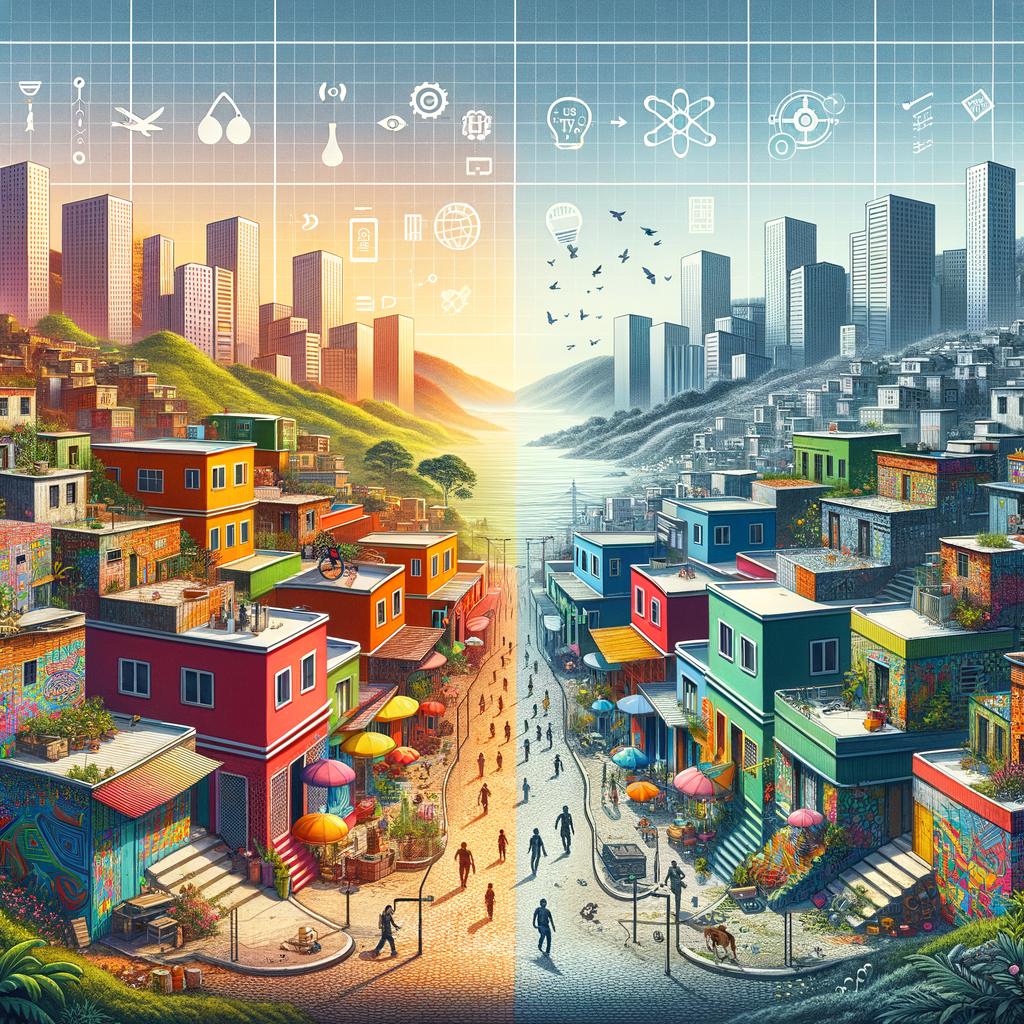In the vibrant heart of Brazil, amidst the maze of bustling streets and colorful murals, lies a story of transformation and resilience. The Favela-Bairro initiative stands as a testament to the power of community and innovative urban planning, breathing new life into some of the most overlooked neighborhoods in the country. This pioneering project, initiated in the late 1990s, seeks not only to improve physical infrastructure but to elevate the very spirit of these communities by integrating them into the broader social and economic fabric of urban life. As we explore the layers of this initiative, we uncover a narrative of hope, highlighting the blending of grassroots participation with government intervention, and the unfolding journey towards inclusivity in one of the world’s most dynamic cities. Join us as we delve into the successes and challenges of Favela-Bairro, a landmark case study in revitalizing communities and fostering a sense of belonging for all.
Exploring the Origins and Goals of the Favela-Bairro Initiative
The Favela-Bairro initiative emerged as a response to the pervasive socio-economic disparities experienced by residents in Brazilian favelas. Launched in the mid-1990s, this innovative urban planning program sought to integrate these marginalized communities into the broader fabric of the city. By focusing on infrastructure improvements, the initiative aimed to address the challenges faced by residents, including lack of access to basic services, inadequate housing, and public safety concerns. Key objectives included:
- Urban Integration: Creating seamless connections between favelas and surrounding urban areas.
- Infrastructure Investment: Enhancing essential services such as sanitation, transportation, and electricity.
- Community Participation: Involving locals in the planning and decision-making processes to empower residents.
Moreover, the initiative champions the idea of transforming favelas not merely as areas to be improved but as vibrant communities with unique cultural identities. This shift in perspective is pivotal for fostering a sense of belonging and pride among residents. The Favela-Bairro program also emphasizes sustainable development through:
| Focus Area | Goals |
|---|---|
| Public Spaces | Creating parks and recreational areas to promote community interaction. |
| Housing | Improving living conditions without displacing families. |
| Social Programs | Providing education and job training to uplift residents. |

Transforming Urban Landscapes: Architectural Innovations in Favelas
In the heart of Brazil, innovative architectural approaches are reshaping the way we perceive favelas, turning them from stigmatized environments into vibrant urban landscapes. The Favela-Bairro initiative exemplifies this transformation by integrating modern design principles with the unique cultural fabric of these communities. This approach does not merely seek to provide housing; it aims to create a functional urban ecosystem that includes:
- Public spaces: Parks and plazas that foster community engagement.
- Accessible infrastructure: Roads and public transport that improve mobility.
- Eco-friendly designs: Sustainable materials and practices that harmonize with the environment.
This initiative breathes new life into the communities by incorporating local artisans and craftsmen into the building process, ensuring that the architecture reflects the identity of the residents. Through these collaborations, the Favela-Bairro initiative enhances not only the aesthetic quality of the neighborhoods but also empowers the locals by providing them with employment opportunities and bolstering the economy. The results are evident in the revitalized streets, where buildings often feature:
| Innovation | Impact |
|---|---|
| Community Centers | Fostering social connections and providing services. |
| Colorful Murals | Enhancing neighborhood pride and cultural expression. |
| Green Roofs | Improving air quality and providing urban gardens. |

Empowering Residents: Community Engagement and Social Programs
At the heart of the Favela-Bairro initiative lies a commitment to fostering active participation among residents. This program emphasizes the importance of community engagement, recognizing that those who live in these neighborhoods are the best sources of insight and innovation. By enabling residents to voice their opinions and contribute to decision-making processes, the initiative cultivates a sense of ownership and responsibility. Key strategies include:
- Community Workshops: Interactive sessions aimed at educating residents and gathering feedback.
- Local Leadership Training: Empowering individuals to take on leadership roles within their communities.
- Cultural Events: Celebrating local culture and traditions to strengthen community bonds.
Furthermore, this initiative incorporates social programs that directly address the needs of the community, enhancing overall quality of life. By focusing on areas such as education, health, and economic development, the Favela-Bairro initiative makes strides in uplifting communities. Some of the crucial programs include:
| Program | Description |
|---|---|
| Educational Support | After-school programs providing tutoring and resources for students. |
| Health Initiatives | Mobile health clinics offering services to underserved areas. |
| Job Training | Skills development programs aimed at improving employment opportunities. |

Sustainable Success: Strategies for Long-Term Benefits and Replication
The Favela-Bairro initiative serves as a model for sustainable community development through a multifaceted approach that focuses on both physical infrastructure and social empowerment. By integrating formal urban design with community input, the program has successfully transformed favelas into neighborhoods that offer not only improved living conditions but also enhanced social cohesion. Key strategies include:
- Community Engagement: Local residents actively participate in planning processes, ensuring that developments meet their needs.
- Infrastructure Investment: Upgrades in sanitation, transportation, and public spaces create an attractive living environment.
- Economic Opportunities: Support for local businesses and vocational training programs fosters economic independence.
To promote replication of this initiative in other regions, stakeholders can adopt a flexible framework that encourages adaptability while maintaining core principles. This includes establishing partnerships with NGOs, government agencies, and private sectors to sustain funding and expertise. A clear set of performance indicators will help measure success, with a focus on:
| Indicator | Description |
|---|---|
| Community Satisfaction | Measuring residents’ satisfaction with changes made. |
| Economic Growth | Tracking the increase in local business revenue. |
| Public Health | Improvement in health indicators such as sanitation access. |
Concluding Remarks
As we draw the curtain on our exploration of Brazil’s Favela-Bairro initiative, it becomes clear that the journey toward revitalizing communities is both complex and profoundly human. This multifaceted program serves not only as a blueprint for urban transformation but also as a testament to the resilience and creativity of those who call the favelas home. By fostering participation, enhancing infrastructure, and promoting social cohesion, Favela-Bairro highlights the importance of inclusive development in addressing the challenges faced by marginalized communities.
While the initiative has made significant strides, the journey is far from over. Each community has its unique narrative, shaping the future of urban living in Brazil. As we look ahead, it is essential to maintain a dialogue about sustainable practices and the continuous evolution of such initiatives. The lessons learned from Favela-Bairro can inspire both local and global contexts, reminding us that the revitalization of communities is not merely an end goal, but a continuous process of engagement and empowerment.
In closing, we invite readers to reflect on the stories, struggles, and successes that emerge from the favelas. Together, we can envision a future where resilience flourishes, and vibrant, inclusive communities thrive for generations to come.

